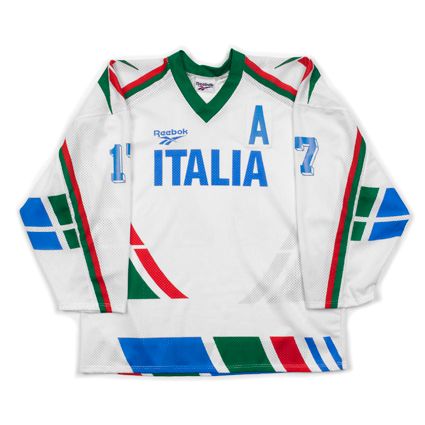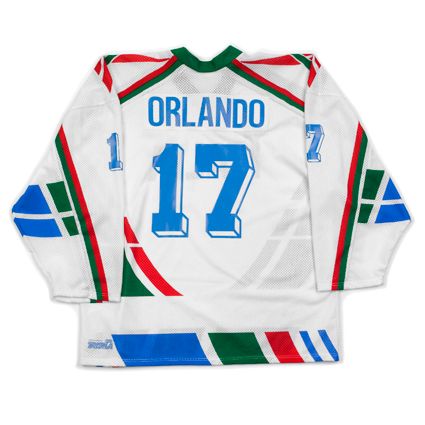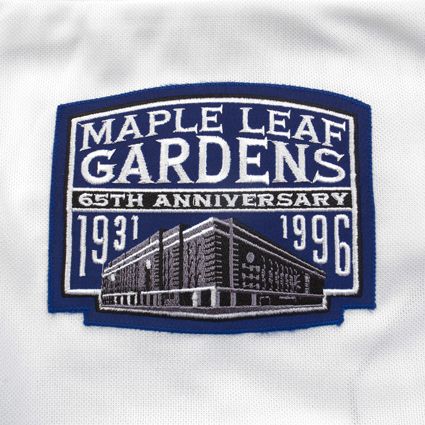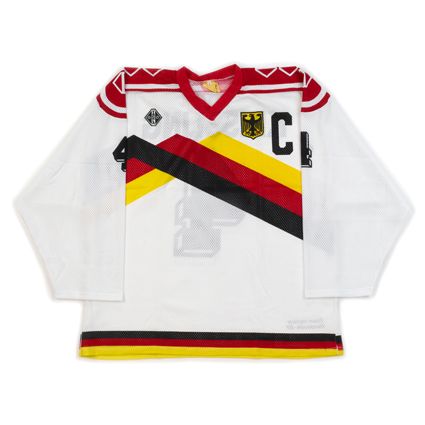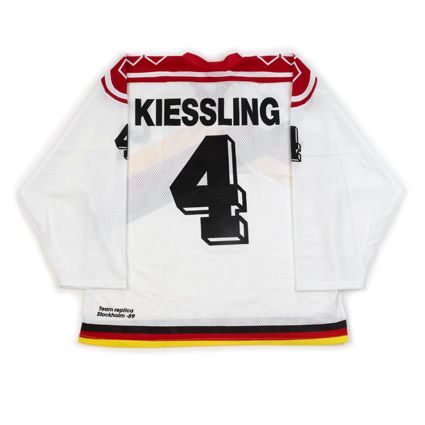
Saturday, November 14, 2009
1991-92 St. Louis Blues Brett Hull Jersey
On this date in 1998, Brett Hull, then with the Dallas Stars, scored his 1,000th point versus the Boston Bruins, the 53rd player to reach that elusive mark.

Entering the game with 997 points, Hull moved one closer to 1000 with an unassisted goal from a deflection off of Jason Allison's skate past Byron Dafoe at 4:20 of the first period to tie the game at 1-1.
Point #999 came at 15:34 of the third period off a bad-angle wrist shot to give the Stars a 2-1 lead.
With his teammates trying to set him up for point #1,000 and a hat-trick, Hull hit the post from the slot with less than a minute remaining. Both Hull and the puck ended up behind the net, where Hull fed Jere Lehtinen who buried the puck in the goal, cementing a 3-1 Dallas win and earning Hull an assist for his 1000th point in his 815th game.
With his 1,000th point, Brett and his father Bobby Hull became the only father-son combination to reach the 1,000 points plateau.
"It's a weird feeling, " said Hull. "You start out in this league just hoping to make it and score a few goals to prove yourself. A thousand points seems kind of of mind-boggling. I can go now and say my name could be put up there with the greats of the game. You hope to get one goal in this game, but to say I have 500 goals and 1000 points is a thrill. I"ll long remember this night."
Hull and the Dallas Stars would cap off the season by winning the Stanley Cup in six games with Hull scoring the cup clinching goal at 14:51 of the third overtime.

Today's featured jersey is a CCM 1991-92 St. Louis Blues Brett Hull jersey from a season in which he scored 70 goals and had 109 points.
This jersey features both the NHL 75th Anniversary patch as well as the St. Louis Blues 25th Anniversary patch on the left sleeve.
The Blues wore this style from 1987-88 to 1993-94, the peak of Hull offensive dominance. Hull registered seasons of 84, 113, 131, 109, 101 and 97 points while wearing this style sweater, with some astounding goal scoring totals of 72 in 1989-90 followed by 86 in 1990-91, the second most in league history in a single season, and the 70 he scored while wearing today's featured jersey in 1991-92 with the additional anniversary patches.
Just this week, Brett Hull was inducted into the Hockey Hall of Fame and here is his speech.
Here is the tribute video from the St. Louis Blues on the night they retired Hull's #16 jersey in St. Louis.
Here is Hull scoring his 50th goal in just 49 games. Only the 5th player to score 50 goals in 50 games. He would repeat the feat in 50 games the following season wearing today's featured jeresy, and would be the last player to date to accomplish the feat.
Finally, Brett Hull visits David Letterman on the occasion of scoring his 50th goal in 1989-90, joining his father as the only father-son 50 goal scorers.
Labels:
Hull Brett,
St. Louis Blues
Friday, November 13, 2009
1994 Italy National Team Gates Orlando Jersey
Born on this date in Montreal, Quebec in 1962, Gaetano "Gates" Orlando was drafted 164th overall in the 8th round by the Buffalo Sabres in the 1981 NHL Entry Draft.
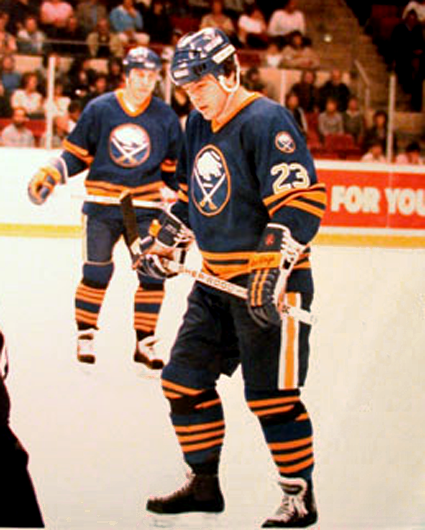
Orlando during his time with Buffalo in the NHL

Orlando with SC Bern
He would make his NHL debut in the 1984-85 season for the Sabres after four years at Providence College and get into 11 games that season, which included scoring his first NHL goal, one of three he would get, along with six assists during his time with the Sabres. He would also compete for the Sabres top farm team, the Rochester Americans of the AHL, putting up strong numbers, with 56 points in 49 games.
60 games with the Sabres would follow the next season, with Orlando scoring 13 goals and 12 assists for 25 points. In 1986-87 he would split time between Buffalo, 10 points in 27 games, and Rochester, where he would again score more than a point per game with 64 points in 44 games.

The 1987-88 season would be one of change for Orlando, as he would play in 13 games for the Americans, with 17 points in 13 games, but then move to HC Merano in Serie A, the top professional league in Italy. His skills would become immediately apparent as Orlando would tear up the league on his arrival with 49 goals and 44 assists for 93 points in a 36 game season, a 2.58 point per game clip, tying him for ninth in league scoring and leading Merano to a second place finish.
A move to HC Bolzano would follow for the 1989-89 season and he would score 79 points in 34 games.
1989-90 was a record setting season for Orlando, as he would net personal highs in goals (64), assists (62) and points with 126, good for 5th place in Serie A scoring and lead Bolzano to the league championship.
The following season would see Orlando compete in 37 games, posting 47 goals and 95 points.
1991-92 saw a move to the Milan Devils and Orlando would score 71 points and help the team capture the Serie A Championship while winning his first league scoring title. The following season Orlando score 41 points and the Milan Devils again would take their second consecutive championship title. The next season would see the Milano Devils undergo a name change to AC Milan Hockey and Orlando's offensive numbers would rebound to 78 points, winning his second scoring title, and the newly renamed club would capture their third league championship in a row.
Orlando moved to the Swiss National League for the next five seasons, first with SC Bern. 55 points in 36 games in 1994-95 would be followed by 41 the next. 1996-97 would see Orlando lead the league in scoring with 82 points from 26 goals and 56 assists in 46 games as Bern would finish atop the league standings and capture the championship.

After one final season with Bern, he would move to Lugano, helping them to the league championship, Orlando's sixth championship in 12 seasons in Europe.
Orlando's Italian heritage qualified him to play internationally for Italy, which hid did often, participating in the World Championships B Pool, finishing second in 1990, when he was the leading scorer of the tournament and named Best Forward, and then first in 1991, earning Italy promotion to the top level A Pool, where Orlando would compete eight consecutive years from 1992 through 1999, comfortably avoiding relegation each time, with a high of sixth place in 1994.
Orlando would also skate for Italy in the Olympics in 1994 in Lillehammer, Norway, where Italy would finish with a 3-4 record and Orlando's 3 goals and 6 assists for 9 points tied him for second place in scoring with Miroslav Satan, Peter Stastny and Haakan Loob only one point behind Ziggy Palffy's 10 points.
He would again compete in the 1998 Olympics in Nagano, Japan, where Italy would finish in 12th place with a 1-3 record after failing to advance past the preliminary round.
Orlando was named to the Rochester Americans Hall of Fame in 2008.
Today's featured jersey is a Reebok Italian National Team Gates Orlando jersey as worn in the 1994 Olympics in Lillehammer, Norway and the 1994 and 1995 World Championships.
Not much in the way of video today, but here is documented proof that Orlando was in the NHL at one point and probably should have kept his gloves on.
Here is a mix of highlights of Team Italy, which look to be a mix from around 2006 and some from 1994.
Labels:
Italy,
Orlando Gates
2009-10 Montreal Canadiens 1910-11 Centennial Jersey
This past Tuesday the Montreal Canadiens broke out their 1910-11 Throwback jerseys as part of their centennial celebrations for the first of two games this season. The original jerseys date back to the Canadiens second ever season and predate the NHL by seven years.


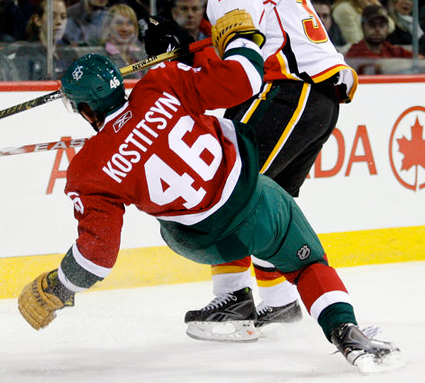

On Tuesday the Canadiens ran into an on form Miikka Kiprusoff and the Calgary Flames, who made a first period goal at 14:55 by Jarome Iginla hold up for a 1-0 Flames win in Montreal. Jaroslav Halak got the start for Montreal and made 30 saves.
The original jerseys were worn by the Montreal Canadiens for just one season by players such as the legendary goaltender Georges Vezina (inducted into the Hall of Fame in 1945), Newsy Lalonde (1950), Jack Laviolette (1962) and Didier Pitre (1962), while the Canadiens were members of the National Hockey Association (NHA), a predecessor to the NHL. The 1910-11 Canadiens would finish the 16 game schedule in second place with an 8-8 record in the five team league.

These 1910-11 throwback jerseys are to be worn one more time on January 23, 2010 against the New York Rangers.
The original sweaters did not have names or numbers on the back, but Montreal used one color white names and numbers for their game against Calgary. While we suppose numbers are fairly essential for modern hockey, and probably mandated by the rule book, they could have left the names off the back for a game to enhance the throwback look and feel in our opinion.

With a review of the game, once again it's Marie-Pier from HabsOrDie.com. For the Canadiens having been shut out, she seems rather perky and not very upset. At least we think that's what she's talking about. Either way, it's the best eight minutes of your day waiting to happen.
If you are a fan of this throwback look, we shamelessly invite you to visit the Third String Goalie online store for a little head start on your Christmas shopping this year.
Labels:
Montreal Canadiens
Thursday, November 12, 2009
1996-97 Toronto Maple Leafs Mats Sundin Jersey
Built during the Great Depression, Maple Leaf Gardens hosted it's first game on this date in 1931.
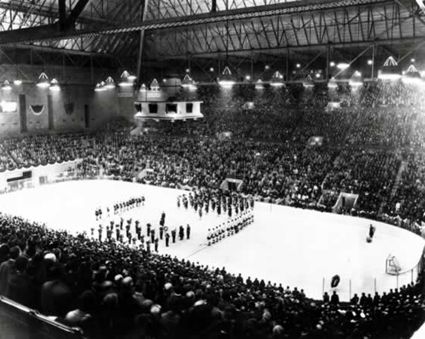
Opening Night - November 12, 1931 - Toronto vs. Chicago
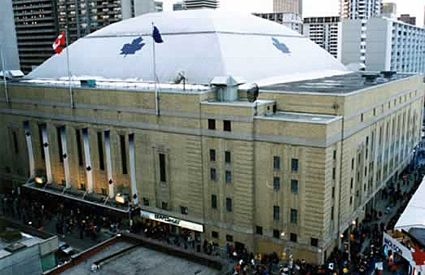
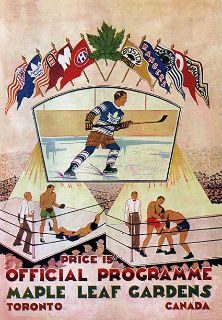
Program cover from the first game at Maple Leaf Gardens

1932 Stanley Cup Champion Toronto Maple Leafs
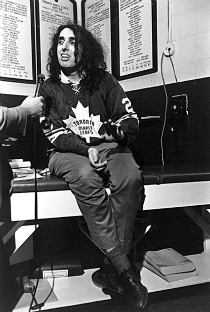
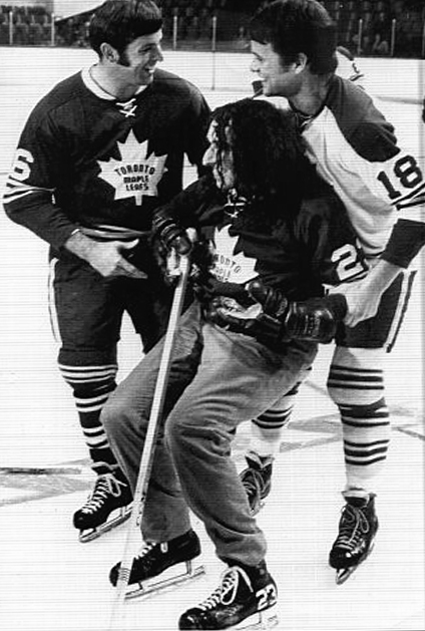

Maple Leafs Captain Teeder Kennedy greets the then Princess Elizabeth
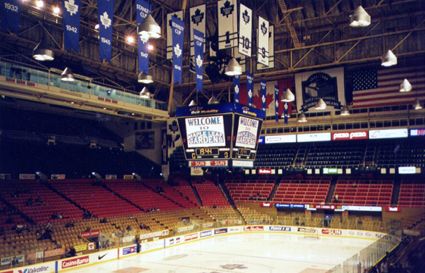

Tex Rickard, seeing the success of the New York Americans hockey club who played the 1925-26 season in his brand new Madison Square Garden, wanted a team of his own.
Conn Smythe, then the coach of the University of Toronto hockey team, was hired as the Rangers General Manager for a sum of $10,000. He acquired Lorne Chabot, Bill Cook, Frank Boucher, Ching Johnson and 27 other players for a total of just $32,000. Rangers president Colonel John S. Hammond had a falling out with Smythe and fired him just prior to the start of the season, as well as keeping $2500 of Smythe's promised money.
When Rangers owner Tex Rickard offered Smythe a job as vice president after the Rangers opening night victory, Smythe told Rickard not only would he not work with the Rangers management again, but how they cheated him out of his full pay. Rickard paid Smythe the remainder of the money he was due and asked him to stay. It was too late, however, as Smythe returned to Toronto and vowed to win the Stanley Cup in revenge.
Smythe took the money he received from Rickard and bet it on a football game and won. He took his winnings and next bet on a Toronto St. Pats hockey game and was a winner once more. Smythe then organized a group of other investors and bought the St. Patricks for $164,000, preventing a sale to a Philadelphia group who had offered $200,000 by promising to keep the club in Toronto.
When Smythe took control of the team on February 14, 1927 he thought the name "St. Patricks" was too Irish Catholic and immediately renamed the team the Maple Leafs and changing their colors to the blue and white of the University of Toronto.
Smythe worked to build the Maple Leafs into a contender and made the playoffs for the first time in four seasons in 1929.
Then, after four seasons of playing in the Toronto Arena, Smythe had Maple Leaf Gardens constructed in under six months for $1.5 million - just 100 yards from where Smythe was born - in order to accommodate more fans to meet the rising cost of players.

The first game ever at Maple Leafs Gardens was a 2-1 loss to the Chicago Blackhawks in front of 13,542 fans, with the top ticket price being $2.75.

Despite the opening night loss, the Maple Leafs would go on to qualify for the playoffs in 1931, beating the Chicago Blackhawks in the opening round and next eliminating the Montreal Maroons to earn a trip to the finals. Smythe would gain his revenge on the Rangers, as the Maple Leafs would defeat New York three games to none, capturing the Stanley Cup at home in Maple Leaf Gardens, a fine way to cap off the first season at the new arena.

Many other events were held at Maple Leaf Gardens over time, including professional wrestling, boxing, basketball, political rallies and concerts, including Frank Sinatra, Elvis Presley, The Beatles and... Tiny Tim.


Maple Leaf Gardens even hosted a hockey exhibition for the future Queen of England, Elizabeth II in 1951.

In addition to the Maple Leafs of the NHL, many other teams also called the building home. The Toronto Lions of the OHA, the Toronto Marlboros of the OHL and the Toronto Toros of the WHA all played hockey, the Toronto Huskies of the BAA (later the NBA) and the Buffalo Braves and Toronto Raptors of the NBA played some basketball, the Toronto Bilzzard of the NASL and Toronto Shooting Stars (NPSL) called it home for indoor soccer and the Toronto Rock of the NLL played professional lacrosse there. Maple Leaf Gardens was also the first hockey arena to have plexiglass at the ends of the rink.
The Maple Leafs became so popular that the team sold out every single game they played between 1946 and their final game in the arena in 1999 - 54 years of sold out hockey in total. As a result of the demand for Maple Leafs tickets, seats were added again and again throughout its history, increasing from 13,542 on opening night in 1931 to 16,307 by 1968, including taking down a large portrait of Queen Elizabeth II to make room for more seating!

Eventually, the Maple Leafs would move to the brand new Air Canada Centre, complete with the luxury boxes that the old arena lacked, in 1999 after 67 years of playing in Maple Leaf Gardens.
Today's featured jersey is a 1996-97 Toronto Maple Leafs Mats Sundin jersey, which features the classy Maple Leaf Gardens 65th Anniversary patch on the upper right chest. Sundin was still the assistant captain at the time and this jersey has the appropriate "A" on the left chest.
This style of Maple Leafs jersey had it's origins in the NHL 75th anniversary season of 1991-92 when each of the Original 6 teams wore a throwback jersey, the Maple Leafs being based on their 1938-1958 style sweaters. The jersey was so well received that the basic jersey style became the basis for Toronto's new 1992-93 jerseys, only now with the retro maple leaf crest made into a secondary shoulder patch while the team's current modern maple leaf crest remained for used on the front.
This new jersey style was used unchanged until 1997-98 when an unfortunately modern name and number font was employed through 1999-00. Toronto then went back to a more traditional number font, while retaining the new font for the names on the back. Other new additions were the new "TML" monogram for the secondary shoulder patches as well as silver trim around the numbers and monogram. This third generation of today's featured style was employed through the 2006-07 season when the entire league got new jerseys in the change to the new Reebok Edge jerseys.
The story goes that the original plan was for the new Edge jerseys to be tucked into the player's pants, so the Maple Leafs jerseys were created without any waist striping and lacked any shoulder patches, leaving an extraordinarily plain looking jersey. Still, it would last until 2009-10 until the Maple Leafs would return to a nearly identical Edge version of today's featured jersey (including the return of the retro leaf shoulder patches) for the 2010-11 season, only now with the addition of a retro lace-up collar as used from 1958 to 1967.
This style of Maple Leafs jersey had it's origins in the NHL 75th anniversary season of 1991-92 when each of the Original 6 teams wore a throwback jersey, the Maple Leafs being based on their 1938-1958 style sweaters. The jersey was so well received that the basic jersey style became the basis for Toronto's new 1992-93 jerseys, only now with the retro maple leaf crest made into a secondary shoulder patch while the team's current modern maple leaf crest remained for used on the front.
This new jersey style was used unchanged until 1997-98 when an unfortunately modern name and number font was employed through 1999-00. Toronto then went back to a more traditional number font, while retaining the new font for the names on the back. Other new additions were the new "TML" monogram for the secondary shoulder patches as well as silver trim around the numbers and monogram. This third generation of today's featured style was employed through the 2006-07 season when the entire league got new jerseys in the change to the new Reebok Edge jerseys.
The story goes that the original plan was for the new Edge jerseys to be tucked into the player's pants, so the Maple Leafs jerseys were created without any waist striping and lacked any shoulder patches, leaving an extraordinarily plain looking jersey. Still, it would last until 2009-10 until the Maple Leafs would return to a nearly identical Edge version of today's featured jersey (including the return of the retro leaf shoulder patches) for the 2010-11 season, only now with the addition of a retro lace-up collar as used from 1958 to 1967.
On a personal note, we had the good fortune to see a game at Maple Leaf Gardens once. While driving into Toronto we heard on the radio that the Maple Leafs were going to be playing their first pre-season game of the year versus the Quebec Nordiques in a couple of days time. Our original plan was to see a Toronto Blue Jays baseball game at SkyDome during it's first year of operation, 1989, and a visit to the Hockey Hall of Fame, which had yet to relocate to downtown Toronto, with no idea that there would also be a hockey game happening during our stay.
Even more to our surprise was discovering that we were staying at the Days Inn on Carlton Street, located about three feet west of Maple Leaf Gardens - which was right next door!
Our lasting memory of the grand old arena? It was THE smokiest non-smoking building we've ever been in. A true throwback to the days of the original six inhabited by throwback men who did things they way they were used to, modern rules be damned.
Labels:
Maple Leaf Gardens,
Sundin Mats,
Toronto Maple Leafs
Wednesday, November 11, 2009
1930-31 Philadelphia Quakers Bill Hutton Jersey
On this date back in 1930, NHL hockey made it's debut in the City of Brotherly Love, as the Philadelphia Quakers faced off for the first time ever.
The team had relocated from their previous home in Pittsburgh, where they were known as the Pirates. The owners of the Pittsburgh Pirates were $400,000 in debt and needed a new arena in Pittsburgh and asked permission to relocate the team to Philadelphia, temporarily, until a new arena could be constructed in Pittsburgh.

The Quakers were nothing short of a disaster. It wasn't until the third game of the season that they managed to score their first goal and they completed the season with a record of 4 wins, 36 losses and 4 ties. Their .136 winning percentage was an NHL record low that would stand for 45 years.
As one would assume with a record such as that, the Quakers had the fewest goals scored and gave up the most goals against that season.
Making matters worse for the Quakers, they had competition from the Philadelphia Arrows of the Can-Am Hockey League, who had a three season head start on the Quakers, with whom they shared the Philadelphia Arena with.
The one notable player for the Quakers was Syd Howe, who started his career with the Ottawa Senators, then played for the Philadelphia Quakers before moving on to the Toronto Maple Leafs, Ottawa Senators, relocated with them when they became the St. Louis Eagles and Ottawa Senators before joining the Detroit Red Wings for 12 seasons. Syd, no relation to Gordie Howe, would retire as the NHL's leading scorer with 237 goals and 291 assists for 528 points when he retired in 1946.

Rather than move back to Pittsburgh for the next season as originally hoped, the owners did not field a team anywhere the next season. Finally after five non-playing seasons during the heart of the depression the owners officially cancelled their franchise when a new arena was never constructed in either Pittsburgh or Philadelphia.
During the era of the depression, four of the ten NHL clubs would fold, leaving what is now known as "The Original Six". Aside from the Pittsburgh Pirates/Philadelphia Quakers who folded in 1931, the Ottawa Senators/St. Louis Eagles ceased to be in 1935, the Montreal Maroons folded in 1938 and New York Americans would fall by the wayside in 1942.
NHL hockey would not return to either Philadelphia or Pittsburgh until 1967, with the arrival of the Flyers and Penguins.
Today's featured jersey is a 1930-31 Philadelphia Quakers Bill Hutton jersey from their only season in the NHL. Hutton was a defenseman who joined the Quakers during the season and played in 21 of their 44 games.
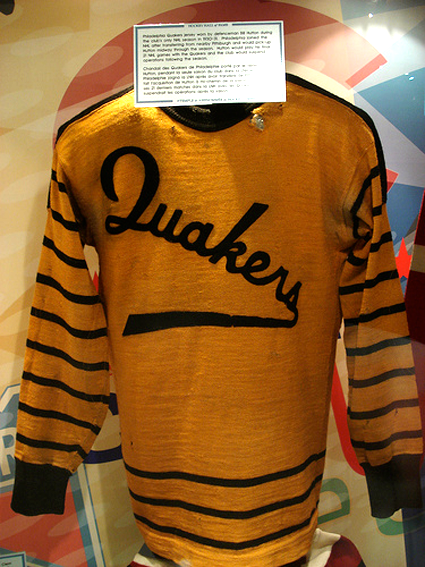
Labels:
Philadelphia Quakers
Tuesday, November 10, 2009
1998 Team USA Jeremy Roenick Jersey
It was on this date in 2007 that Jeremy Roenick of the San Jose Sharks scored his 500th NHL goal, the 40th such player to reach the 500 goal mark.
Roenick was a player that drove us crazy here at Third String Goalie. He could be a fan favorite, then a villain and back again as quick, and as often as any player we have followed. It appeared at times that his mouth and his brain were not connected, or at the very least the filter between them had been removed.
Drafted eighth overall in the 1988 NHL Entry Draft by the Chicago Blackhawks, the Boston native got his first NHL game action on October 6, 1988 and played 20 games with the Blackhawks that season, scoring 18 points. He established himself as an NHL regular the following season and scored 66 points in 78 games and became a fan favorite with his all-out, impulsive style.
The best offensive years of his career followed, as he scored 94, 103, 107 and 107 points again from 1990-91 to 1993-94, reaching 53 goals for a career high in 1991-92 and 50 more the following season. It was the peak of his scoring, as he would never top 80 points again in the remaining 14 years of his career.
The lockout shortened season of 1994-95 would see him finish with 34 points in 33 games. After an acrimonious split with the Blackhawks over his contract, which he was more than happy to spout off about in public to the annoyance of the Blackhawks ownership, he was traded to the Phoenix Coyotes in the summer of 1996 and scored between 24 and 34 goals in his five seasons with Phoenix, leading the team in scoring during his last three seasons with the Coyotes. One of his most famous moments that made you love him was playing with his jaw wired shut after an injury for a Game 7 in the 1997 playoffs.
He would sign as a free agent with the Philadelphia Flyers in 2001 and lead the Flyers in scoring his first two seasons in Philadelphia and score his 1000th NHL point on January 30, 2001.
Following the NHL lockout, the Flyers traded Roenick to the Los Angeles Kings in a salary cap move. Limited to 58 games, he would score just 22 points on the season. It was a less than happy time in Los Angeles and he did not endear himself to the Kings or their fans with his performance that season, something he will freely admit.
After one season in Los Angeles, 2006-07 would see a return to Phoenix for a second time. He would score 11 goals in 70 games, leaving him at 495 career goals and the end of the season.
After contemplating, and at one point even sending a newspaper his retirement announcement, Roenick signed with the San Jose Sharks for the 2007-08 season. It was as a Shark on this date in 2007 that Roenick scored his 500th career goal against Alex Auld off a crazy play, where Roenick dumped the puck into the corner of the Coyotes zone from center ice, saw the puck bounce off the end boards, hit the side of the net, bounce off and hit Auld, deflect into the crease and then, somehow, Auld then directed the puck into his own net! To fully appreciate the comic nature of the event, be certain to watch the video below. Roenick became only the third American to reach 500 goals after Joe Mullen and Mike Modano. Two months later he would pass Mullen for second place among American goal scorers. While he would only tally 14 goals that season, ten of them were game winners.
In the playoffs that year, Roenick would rekindle his old scoring touch when it mattered the most with two goals and two assists in Game 7 to eliminate the Calgary Flames.
2008-09 would see Roenick return for another year with the Sharks, playing in 42 games and notching his 700th assist on February 21, 2009.
His final career totals were 513 goals and 703 assists for 1216 points, plus an additional 53 goals and 69 assists for 122 points in 154 playoff games. He would also compete in 9 NHL All-Star Games during his career.
Internationally, Roenick was proud to suit up for Team USA and did so six times. He would play in two World Junior Championships, in 1988 and 1989, the World Championships in the spring of 1991 and the Canada Cup, earning a silver medal, later in September of 1991. He would also compete in the Winter Olympics in 1998 and again in 2002 in Salt Lake City where he earned a silver medal.
He could be the most humble and fan friendly player at times, as evidenced by what we saw in person at the 2004 NHL All-Star Practice, when Roenick stayed on the ice long after the rest of the players had left to sign jersey after jersey for a group of fans with Roenick jerseys, but then he could undo all that goodwill by saying some of the stupidest, most ill-advised things, like during the 2004-05 lockout telling the fans to "kiss my ass" when talking about fans who perceived NHL players as being spoiled and that he would prefer if those fans no longer attended NHL games or even watch them on TV.
And just when you learned to like him again, he'd go and do it again, such as when he spouted off about being left off the American squad for the 2006 Winter Olympics, even though he only had 13 points in 32 games at the time, and threatened to cheer for Canada!
Today's featured jersey is a 1998 Team USA Jeremy Roenick jersey as worn in the 1998 Olympics held in Nagano, Japan.
The United States first participation in the Olympics in which the NHL suspended it's season to allow it's players to compete was a disappointment for the US team, as they went 1-2 in the Final Round Group A with a 4-2 loss to Sweden, an expected 5-2 defeat of Belarus and a 4-1 loss to Canada followed by a quick exit from the tournament after a defeat by the eventual champions the Czech Republic by a score of 4-1. Roenick had one assist in four games for the Americans.
Here is Roenick's ultra-quirky 500th career goal, which came after a dump-in aimed no where near the net and expertly guided into his own net by Alex Alud after a series of rebounds and odd deflections. By the time the puck ended up in the net, Roenick was lucky to not be sitting on the bench!
Dasherboard: The NHL General Managers are set to discuss the Trapezoid Rule at their meetings which limits the area behind the goal line in which goalies are allowed to handle the puck. The rule was put into place in order to make it more difficult for the defensive team to clear the puck out of their own zone and thus create the league desired "more scoring chances".
One argument against the rule is that it has resulted in more injuries, as players take long runs back into the zone in an effort to gain control of the puck, attacking players have been plastering defensive players into the boards with a frequency and ferocity that did not exist before when the goalie would retrieve the puck and send it back the other way or around the boards to a teammate, negating the chase to the puck that happens now.
If the trapezoid is removed for safety reasons, how could they not implement no-touch icing at the same time, a proven danger to defenders for years. If you don't believe me, or Don Cherry, just ask Kurtis Foster.
Which bring us to our point. If they do keep the Trapezoid Rule in order to maintain the beloved "scoring chances" how on Earth can they still allow the hand-pass in the defensive zone?
It's the worst rule in hockey. The basic premise of the game of hockey is to move the puck forward with your stick. Your stick. The hand-pass goes against the basic tenant of the game, helps the defense and it's aesthetically the worst looking play in hockey.
It's stupid to allow it for half the players on the ice in only one-third of the playing surface. Either let everyone do it everywhere, or don't let anyone do it anywhere.
I believe it was first instituted years ago because defenders were making hand passes on purpose to create stoppages in play while killing penalties, allowing for line changes for the defense, and it was viewed at the time that allowing the hand-pass would keep play moving.
The simple solution would be to outlaw the unsightly hand-pass and call anyone guilty of making one from now on for a delay of game penalty, putting the offending team now two men short and... creating more of the beloved "scoring chances".
The hand-pass is terrible to look at when it happens, goes against the basic spirit of the game and does nothing but make life easier for the defense. Get rid of it!
Labels:
Roenick Jeremy,
USA
Monday, November 9, 2009
The 2009 Hockey Hall of Fame Induction Ceremony
Tonight is the 2009 Hockey Hall of Fame Induction Ceremony for this year's inductees, Brett Hull, Brian Leetch, Luc Robitallie and Steve Yzerman, quite possibly the greatest group of players ever enshrined in the hall at the same time.
Here is our tribute to the four of them on this special night for a special group.








The 2009 Hockey Hall of Fame Induction Ceremony will be broadcast live on TSN in Canada and the NHL Network in Canada and the United States starting at 7 PM Eastern time tonight, November 9th.
1989 West Germany National Team Udo Kiessling Jersey
A momentous occasion occurred in Germany twenty years ago on this date in 1989, as the Berlin Wall fell.
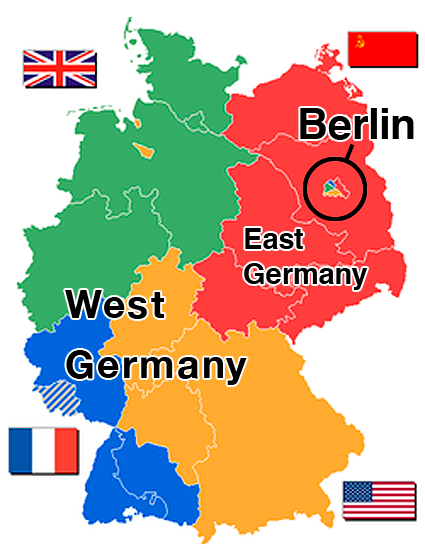

After the conclusion of World War II, Berlin was divided into four sectors. The United States, the United Kingdom and France controlled what became West Berlin, while the Soviet Sector formed East Berlin. The Soviets also controlled the area of Germany that surrounded Berlin as well, leaving the three Allied Sectors of Berlin deep inside Soviet controlled Germany, 100 miles from the nearest Allied controlled part of Germany.

Growing differences between the former allies against Nazi Germany led to the Soviets imposing the Berlin Blockade, cutting off road and train access to West Berlin on June 24, 1948. The Allies responded with the Berlin Airlift, bringing in 13,000 tons of food per day with over 200,000 flights lasting nearly a year until May 12, 1949.
On October 7, 1949 the Soviet controlled part of Germany became a separate country, the German Democratic Republic, or "East Germany", which was heavily influenced and controlled by Soviet authorities. Meanwhile, West Germany operated as a capitalist country with a democratic government and saw it's economy and standard of living growing and improving over time, which attracted many East Germans, who wished to relocate to the more prosperous and free West Germany, away from Soviet control.
The period from 1950-1952 saw 544,000 East Germans move to West Germany and in 1953 another 331,000 migrated to West Germany, fearing an even greater increase in Soviet control. Up until 1952, passing from West Berlin into East Berlin was relatively easy until a system of passes were introduced to restrict movement. At the same time, a declaration was made that the border between the countries of East and West Germany should be considered a dangerous border and a barbed-wire fence was erected between the two countries.
Meanwhile, the border between West and East Berlin still remained open, leaving West Berlin, deep in the heart of East Germany, attracting thousands of East Germans to West Berlin as a gateway to West Germany. By 1956, the East German authorities restricted virtually all travel to West Germany.
The next step in isolating East Germany was a new passport law that reduced the number of people leaving East Germany through the West German border, which increased the percentage of people leaving through West Berlin to over 90% by 1959 since there was no physical barrier in Berlin, such as the barbed wire fence that separated the two countries along their border 100 miles to the west. There was even subway service between East and West Berlin at the time.
This left West Berlin as a tiny island of freedom and a gateway to the West located right in the center of East Germany.
By 1961, approximately 20% of the entire East German population, 3.5 million people, had left East Germany. With the majority of the people leaving being young and well educated, the population of working age people decreased from over 70% to 61% and represented a loss of manpower estimated to be worth from $7 to $9 billion. Finally on August 12, 1961 orders were given to close the border between East Berlin and West Berlin and erect a barrier to prevent any further movement of East German citizens into West Berlin and out of East Germany.

Roads were torn up and barbed wire and fences were erected around the perimeter of West Berlin, stretching for 87 miles. In 1962 a second fence was erected approximately 100 yards further into East Germany, creating what was effectively a moat that offered no protection from armed East German guards, called The Death Strip.
In 1965 the wire fencing was replaced by a concrete wall which eventually grew to be 12 feet tall and nearly 4 feet thick.
During the wall's existence, there were around 5,000 successful escape attempts to West Berlin and the number of people killed trying has been placed between 136 to above 200. Various methods of escape were used, including tunnels, hot air balloons, sliding along overhead wires and ultralight aircraft as well as escaping through the sewer system. On occasion, wounded escapees were left to die in the Death Strip, as any potential rescuers feared being shot at by the East German border guards.
On June 12, 1987, Ronald Reagan challenged Mikhail Gorbachev of the Soviet Union to "Tear down this wall" as a sign of increasing freedoms in the Communist Eastern Europe.
On August 23, 1989, Hungary removed it's border defenses with Austria, allowing more than 13,000 East Germans in Hungary to escape into Austria. The remaining East Germans prevented from leaving flooded the West German embassy in Budapest and refused to return to East Germany. This set up a similar event in Czechoslovakia and mass demonstrations within East Germany. In October, longtime East German leader Erich Honecker resigned and on November 4 a million people gathered in the Alexanderplatz public square.
With Honecker's replacement Egon Krenz's new government tolerating the wave of East Germans leaving through Czechoslovakia, a plan was put into place on November 9, 1989 to allow people to simply leave directly through the checkpoints between East Germany and West Germany, including West Berlin.
Spokesperson Gunter Schabowski was given the assignment of announcing the new policy, however he had not been present at the meeting or fully updated on the details. Shortly before a press conference, he was handed a note that said East Berliners would only be allowed to cross the border with proper permission, but no further information on how to present the news. The new rules were to take effect the next day in order to be able to inform the border guards on the new policy, but no one had told Schabowski, who when asked on live TV when the new rules would take effect, assumed from the wording of the note that it would be the same day, replied "As far as I know effective immediately, without delay." After further questions, he confirmed that this included the border crossings into West Berlin.
Soon afterwards West German television announced that starting immediately, East German borders were open to everyone. Since East Germans had been waiting to hear this news for 28 years, thousands of East Germans went to the border crossings, demanding that the guards open the gates. Unaware of the new rules, the outnumbered and overwhelmed guards tried to call their superiors, but none of them dare give any orders to use lethal force and, without the authority to fire, the guards had no way to hold back the growing crowds and opened the gates. The wall had, in theory, come down.
Initially, the wall stayed intact, but new border crossings were added as previously severed roads were rejoined and various rules remained in effect, which included the need for visa applications in advance for West Berliners to visit the East. The guarding of the wall became more and more relaxed and more and more damage to the wall was tolerated.
Many celebrations were held in the days following, including David Hasslehoff rocking the wall on New Year's Eve 1989.
Roger Waters performed the Pink Floyd album "The Wall" on July 21, 1990 near the Brandenberg Gate.
Finally in June of 1990, the dismantling of the wall officially began and Germany was officially reunified as one country on October 3, 1990.
As for how the separation of Germany after World War II into East Germany and West Germany affected their national hockey team, the East German National Team first competed in 1951 and participated in the World Championships from 1956 on to 1990. They had some success, reaching the highest level, the "A" Pool on a number of occasions, but often being relegated back to the "B" Pool within a year or two. Their highest finish at the World Championships was 5th place, which they managed in 1957, 1965, 1966 and 1970. They were the winners of the "B" Pool on six occasions, each time earning promotion back to the "A" Pool.
The East Germans also competed in the Olympics, first as The Unified Team of Germany, comprising athletes from both East and West Germany as a single team, in 1956, 1960 and 1964, finishing last in 1956 and 1960 and next to last in 1964. They competed as separate teams in 1968, with the East Germans finishing 8th out of 8 with a 0-7-0 record. From 1972 onward they did not compete in the Olympic hockey tournament.
The West Germans won a silver medal in 1953 in their first appearance at the World Championships but generally hovered between 5th and 7th place for the majority of it's existence with the occasional relegation to the "B" pool for a couple of years.
The Olympics were very much the same story, finishing at or near the bottom in 1952, as the Unified Team of Germany in 1956, 1960 and 1964, and as West Germany in 1968, 1972 and 1980. Some improvement was shown in the 1980's, with mid-pack finishes in 1984 and 1988, but 1976 was the highlight of the separate West German program, with a surprising 3rd place finish which earned them the bronze medal behind the dominant Soviet Union and Czechoslovakia.
West Germany began by defeating Switzerland 5-1 in a qualification match to move onto the main group, whose round robin schedule would determine the medal winners.
They opened Group play by defeating Poland 7-4. Losses to Finland (5-3), the Soviet Union (7-3) and Czechoslovakia (7-4) hurt their chances, but a 4-1 win over the United States left West Germany, Finland and the USA all tied with 4 points from two wins in the standings with West Germany winning the tie-breaker and being classified third to take home the bronze.
With the reunification of Germany in 1990, the German National Team once more represented the country as a whole. Their record in the World Championship generally sees them finishing between 7th and 11th, with the occasional relegation to the second level, followed by a quick return to the top division.
Their Olympic record is very much the same, with finishes of each step from 6th to 10th on their record over the last five Olympics.
Today's featured jersey is a 1989 West German National Team Udo Keissling jersey from the World Championships held in Stockholm, Sweden. West Germany would finish the Round Robin portion with a 0-5-2 record, but avoid relegation by finishing with a 1-2-0 record and save themselves from the drop with a 2-0 defeat of Poland.
One of the best players in German hockey history, Udo Kiessling set a new record in 1992 with his 5th consecutive Olympic tournament appearance. Kiessling's record shows he played a single game in the NHL, in 1982 on a tryout after his German club team was an early exit from the playoffs, but returned home to play in the World Championships, never to return to the NHL again. But just because a player is not in the NHL, doesn't mean he doesn't exist, as Kiessling would go onto have a 24 year career, ending in 1996 at the age of 40.
He made his first appearance in the Olympics at Innsbruck in 1976, winning a Bronze Medal. In addition to his five Olympics, Kiessling also participated in 15 World Championships and the 1984 Canada Cup, as well as winning six national titles in Germany, where he was named the top player three times.
This beautiful jersey features the vibrant colors of the dye-sublimation process and the arresting graphics of the era with the colors of the tri-color German flag streaking across the chest, as well as the distinctive Tackla diamond logos on the shoulders and drop shadow block font for the numbers. Easily one of our favorite jerseys.
Today's video selections have some footage of the West German National Team competing in the 1980 Olympics against Sweden and then the United States team, which would go on to pull off the Miracle on Ice against the Soviet Union.
Labels:
Berlin Wall,
East Germany,
Germany,
Keissling Udo
Subscribe to:
Comments (Atom)





